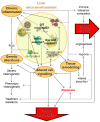Novel aspects of the liver microenvironment in hepatocellular carcinoma pathogenesis and development
- PMID: 24871369
- PMCID: PMC4100103
- DOI: 10.3390/ijms15069422
Novel aspects of the liver microenvironment in hepatocellular carcinoma pathogenesis and development
Abstract
Hepatocellular carcinoma (HCC) is a prevalent primary liver cancer that is derived from hepatocytes and is characterised by high mortality rate and poor prognosis. While HCC is driven by cumulative changes in the hepatocyte genome, it is increasingly recognised that the liver microenvironment plays a pivotal role in HCC propensity, progression and treatment response. The microenvironmental stimuli that have been recognised as being involved in HCC pathogenesis are diverse and include intrahepatic cell subpopulations, such as immune and stellate cells, pathogens, such as hepatitis viruses, and non-cellular factors, such as abnormal extracellular matrix (ECM) and tissue hypoxia. Recently, a number of novel environmental influences have been shown to have an equally dramatic, but previously unrecognized, role in HCC progression. Novel aspects, including diet, gastrointestinal tract (GIT) microflora and circulating microvesicles, are now being recognized as increasingly important in HCC pathogenesis. This review will outline aspects of the HCC microenvironment, including the potential role of GIT microflora and microvesicles, in providing new insights into tumourigenesis and identifying potential novel targets in the treatment of HCC.
Figures


References
-
- Montalto G., Cervello M., Giannitrapani L., Dantona F., Terranova A., Castagnetta L.A. Epidemiology, risk factors, and natural history of hepatocellular carcinoma. Ann. N. Y. Acad. Sci. 2002;963:13–20. - PubMed
Publication types
MeSH terms
LinkOut - more resources
Full Text Sources
Other Literature Sources
Medical

